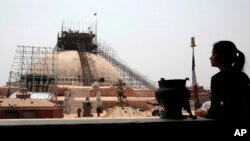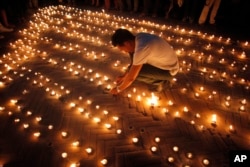Nepal has begun reconstruction of ancient key temples and monuments, including a UNESCO heritage site, that were damaged in a massive earthquake quake one year ago.
Nepali officials say it will take years to fully restore the South Asian country's architectural heritage and rebuild 600,000 homes destroyed in the magnitude-7.8 quake that upended roads in the country and turned mountain villages into rubble.
Memorial services for the nearly 9,000 who died in the earthquake were held Sunday, alongside demonstrations against the slow pace of the Nepalese recovery.
International donors have pledged $4.1 billion toward Nepal's recovery, but only $1.3 billion has been sent to the country, with the government blamed for taking months to set up the National Reconstruction Authority.
In a statement released by the White House Monday, National Security Council spokesperson Ned Prince expressed condolences for the lives lost in the quake and acknowledged that "much of the hard work of rebuilding Nepal still lies ahead."
"We are humbled by those who risked their lives to save others, including the six United States Marines who perished in Nepal while providing relief to Nepalis in need," he said.
In Nepal, protesters chanted "Government, where is reconstruction?" as they tried to force their way into government offices. "Open the gates of the government."
"We are hoping that the government's priorities and perspectives on reconstruction will soon be clear so that we can help people to rebuild and get their lives back on track as quickly as possible," one Red Cross official in Nepal said.
The Red Cross says four million people are living in shelters.
Homeless survivors have been promised about $2,000 in aid, but only several hundred have received the first $500 installment.
Tibetans remain displaced
According to reports by VOA's Tibetan Service, Tibetan villages along Nepal's border, which were also destroyed by that same quake, have yet to be rebuilt, and many of an estimated 100,000 internally displaced Tibetans remains without homes to return to.
On Friday, Tibet Radio, a Chinese official Tibetan language news service, indicated most relocated Tibetans still remain in Shigatse, Tibet's westernmost prefecture-level city. The state newscaster also said Pema Trinlay, vice party secretary of Tibetan Autonomous Region, recently visited the displaced Tibetans and told them that quake reconstruction is a top priority in 2016.
It is not clear whether the construction will focus on rebuilding damaged homes or simply moving displaced Tibetans into newly towns, as Beijing has done before.
Produced in collaboration with VOA's Tibet Service.

